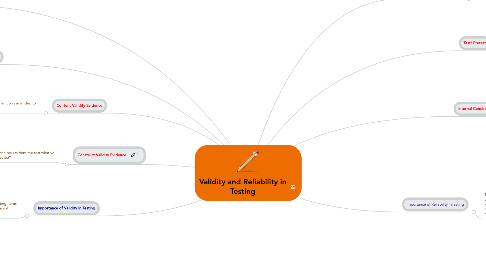Validity and Reliability in Testing
создатель delores janeway


1. Criterion-Related Validity Evidence
1.1. 1. Concurrent- correlating test scores with a certain criterion measure collected at the same time.
1.2. 2. Predictive- correlating test scores with a criterion measure collected after a period of time has passed.
1.2.1. Correlating test scores with an external standard or criterion to obtain a numerical estimate of validity evidence.
2. Construct Validity Evidence
2.1. Are the results from the test what you expected?
2.1.1. Finding whether test results correspond with scores on other variables as predicted by some rationale or theory.
3. Content Validity Evidence
3.1. Does the test measure what it was intended to measure?
3.1.1. Systematically comparing a test item with instructional objectives to see if they match.
4. Importance of Validity in Testing
4.1. To ensure that test items are presenting items that correlate directly to the instructional objectives from the lesson.
4.1.1. Green Belts are primarily recognized as those who's job function requires application of the Six Sigma method.
4.1.2. They may or may not decide to continue the training
5. Validity Evidence
6. Internal Consistency
6.1. Use only when the test measure a single or unitary trait.
6.2. In the split half or odd even methods, correlations are based on half tests, so obtained correlations underestimate reliability of the whole test.
6.3. Kuder Richardson determines the extent to which the entire test represents a single, fairly consistent measure of a concept.
7. Test/ Pretest
7.1. A test is given two times so that the correlation between the two sets of scores can be determined.
8. Reliability Methods
8.1. Reliability Test Methods
8.1.1. Alternate Forms or Equivalents
8.1.1.1. Administer two alternate/equivalent tests to the same group and correlate their scores.
